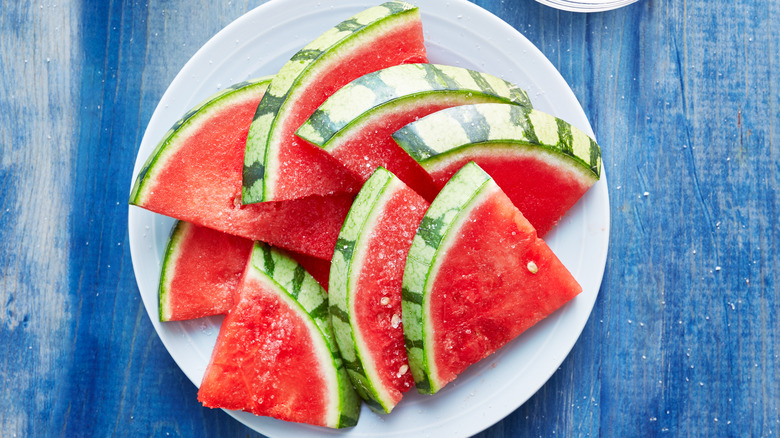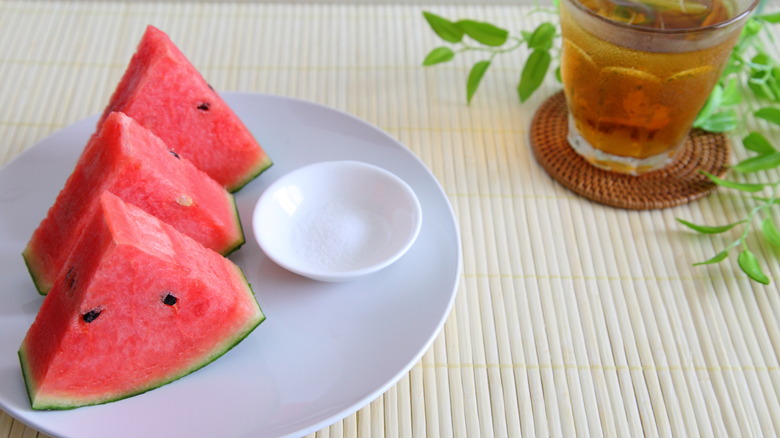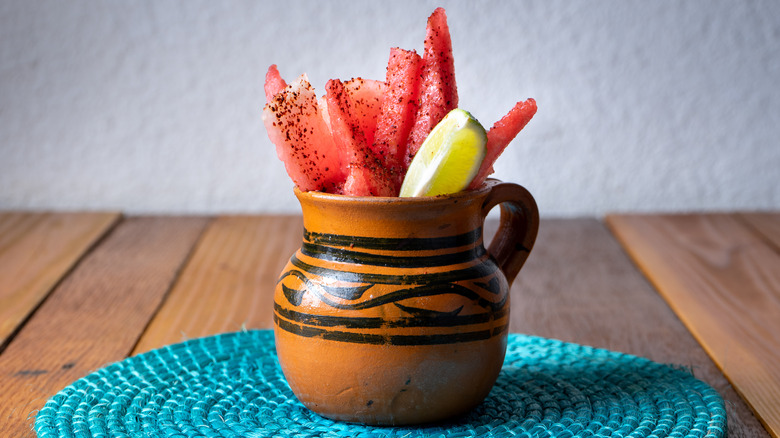Adding A Sprinkle Of Salt To Watermelon Is A Long-Time Southern Tradition
Salted watermelon is as much a part of Southern cooking as are fried green tomatoes, shrimp po boys, and biscuits and gravy, but the salt-on-fruit pairing isn't as well-known outside of the region. This is starting to change, however, as adding a sprinkle of salt to watermelon has started trending, turning the long-time Southern tradition into a viral taste sensation.
While ripe watermelon is delicious on its own, seasoning it with salt elevates the fruit's flavor and texture to a whole other level. Along with its sweet essence, watermelon's profile also has sour and bitter notes. Adding salt brings its inherent sweetness to the forefront, with the bonus of creating a sweet and salty combo that practically everyone loves — think along the lines of peanut butter and jelly, salted caramel, and maple bacon.
Although the concept may be new to some of us in the West and North, salted watermelon has been a staple of Southern hospitality for generations, as common at barbecues, picnics, and church potlucks as macaroni salad, casseroles, and fried chicken. A 1910 edition of South Carolina's The State newspaper published a recipe for watermelon half-frozen with salt and a touch of sherry wine.
The reason the mix works so well is the same as how salting grapefruit tricks your taste buds. Salt inhibits bitter flavors, creating the illusion of increased sweetness. In the case of watermelon, salt also brings out its juicy sugars, making it not only sweeter but also exceptionally succulent.
Why salt on watermelon tastes so good
We have science to thank for the transformation that occurs when salt meets luscious watermelon flesh. Since it's naturally sodium-free, adding salt draws its syrup goodness to the surface. Furthermore, salt triggers salivation; when eating the two together, you get the experience of maximum juiciness.
Acid plays a role in why this flavor pair works so well too. Or rather, it's absence. Watermelon is considered a low-acid food. Since acid neutralizes bitterness, and the fruit has very little of it, salt is the perfect fix for any bitter notes that may otherwise come through.
The appetizing nature of this unexpected flavor combination also makes sense biologically. Even though it's available in the United States year-round, watermelon season peaks in summertime. As is, watermelon is already one of the best fruits for hydration. Adding salt to it actually increases its hydrating abilities due to the fact that sodium is an electrolyte (per the CDC). We lose electrolytes through our sweat, which is why sports drinks like Gatorade contain sodium to help in recovery after a workout. You may notice that you crave salty foods during the hottest months of the year or after heavy physical activity — that's your body's way of telling you to replace some of those lost electrolytes.
You can also fix disappointing watermelon textures with flaky salt. It not only boosts the juice in a dry or mushy melon but also adds an unexpected and appealing crunch.
Salted watermelon around the world
Adding salt to watermelon is not exclusive to the Southern United States, as the culinary trick also shows up on global menus. Latin American food has similar salty-sweet fare which includes using Chamoy on watermelon. Or sprinkle spicy Tajín on mediocre watermelon for a punch of chili pepper, lime, and sea salt that makes the Mexican seasoning a favorite.
Asian countries have their own specialties as well. Vietnamese muối ớt chili salt is perfect on watermelon spears, pineapple skewers, and chunks of guava. In Thailand, traditional drinking foods, known as pok pok, often feature chili salt as a dip for fresh mango or used as a seasoning in green papaya salad.
In Japan, much like the Southern U.S., watermelon and salt is a common treat. There, you can try an exclusive Watermelon Salt Fanta soda that's advertised as a preventative for heat stroke, or head to a Japanese Starbucks where you'll find a watermelon Frappuccino that comes topped with watermelon salt. Even Hawaii has its own specialty known as li hing mui, which is made from dried salted plums and eaten on fresh fruits as well as used as a flavoring for candy.
If you find the idea of salty fruit challenging, consider more familiar dishes that straddle the fence between sweet and savory, like watermelon wrapped in prosciutto, or a grilled melon salad with feta cheese. Try sprinkling salt on your own watermelon as a gateway to Southern (and world) cuisine.



